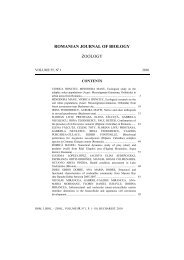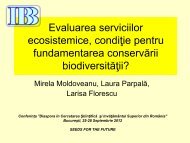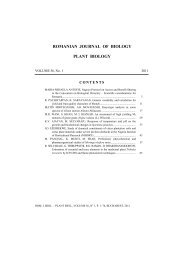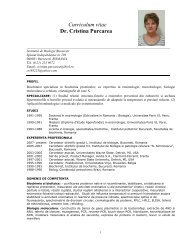class chilopoda: evolution and environment adaptation
class chilopoda: evolution and environment adaptation
class chilopoda: evolution and environment adaptation
You also want an ePaper? Increase the reach of your titles
YUMPU automatically turns print PDFs into web optimized ePapers that Google loves.
CLASS CHILOPODA:EVOLUTION AND ENVIRONMENT ADAPTATIONCAROL-CONSTANTIN PRUNESCUA reconsideration of the first theory about the linear <strong>evolution</strong> of the Class Chilopoda(Prunescu, 1965a), from the short to long chilopods was presented. The most importantarguments were proved by the new anatomical structures discovered in therepresentatives of certain actual orders of Chilopoda. A careful analysis was undertakenabout the main characters of the present orders of chilopods, related to the <strong>adaptation</strong> todistinct <strong>environment</strong>s of life, their hunting peculiarities <strong>and</strong> their behaviors bound to thebrood care or the lack of the brood care (Sub<strong>class</strong> Ovoconecta, Sub<strong>class</strong> Ovodispersa).These arguments led to the conclusion that the chilopods <strong>evolution</strong> developed alongtwo distinct branches, starting from a common ancestor.Key words: Chilopoda, Sub<strong>class</strong> Ovoconecta, Sub<strong>class</strong> Ovodispersa, <strong>environment</strong><strong>adaptation</strong>, <strong>evolution</strong>.INTRODUCTIONThe biological <strong>adaptation</strong> is the process through which an organism isintegrated in its own <strong>environment</strong> of life. The <strong>adaptation</strong> is the result of the actionof natural selection concerning the inherited variations. The <strong>adaptation</strong> refers to themodifications of the structure, physiology, manners of attack <strong>and</strong> defense,reproduction <strong>and</strong> the development of the organism involved, related to thespecificity of the <strong>environment</strong>. Some of these characters are considered as pre<strong>adaptation</strong>traits; they can bring occasionally advantages for the organism. Thestudy of the organism existence in relation with its <strong>environment</strong> defines moreaccurately its <strong>adaptation</strong> capacity.The representatives of the Class Chilopoda express very stable relations withtheir <strong>environment</strong>s of life.The representatives of the order Geophilomorpha live in the profound levelsof the litter <strong>and</strong>/or soil. Occasional the litter or soil may be replaced by big ormedial size stones or the rotten bark of the fallen trees. In these two types of<strong>environment</strong> of life were found also the representatives of the ordersScolopendromorpha <strong>and</strong> Lithobiomorpha. The representatives of these two ordersare frequently found in the superficial levels of the litter under medial or small sizestones, etc.The species of the order Scutigeromorpha live in the free spaces, open orclose, anywhere in the world in a warm <strong>and</strong> wet atmosphere. In Europe, Scutigeracoleoptrata is found in the terrestrial regions around Mediterranean Sea <strong>and</strong>/oraround Black Sea <strong>and</strong> Romanian Danube.ROM. J. BIOL. – ZOOL., VOLUME 55, N o 2, P. 113–127, BUCHAREST, 2010
114 Carol-Constantin Prunescu 2The differences among these <strong>environment</strong>s of life seem not to be very great.However, when we consider their hunting possibilities imposed by the <strong>environment</strong>conditions, these differences become very important. A geophilomorph blind, long<strong>and</strong> coiled, with the displacement by winding which is more frequent than thedisplacement based on the locomotion by articulated legs, hunts easily owing to awell developed sense of touch. Owing to its length, this chilopod controls animportant area of the surrounding soil. The representatives of the orderScolopendromorpha namely the blind <strong>and</strong> pale Cryptopidae shorter thangeophilomorphs <strong>and</strong> the stout <strong>and</strong> pigmented Scolopendra, with a fixed number ofocelli, hunt in the less deep levels of the soil. Their hunting is more active beingbased on the displacement by articulated legs. This fact is valid also for therepresentatives of the order Lithobiomorpha, which for the hunting displace morerapidly than the representatives of the order Scolopendromorpha.In contrast to all these chilopods, the representatives of the orderScutigeromorpha present compound eyes placed on the important surfaces of thecephalic capsule, long antennae with segments multi-fragmented <strong>and</strong> legs withtarses formed of many articles. These characters facilitate an extremely rapiddisplacement during the hunting. The chilopods body structure is correlated with aparticular organization of the displacement based on the segmented body <strong>and</strong>articulated appendages.The manner of hunting bound to the specific character ofthe displacement has important implications in the reproduction <strong>and</strong> developmentthe chilopods.The chilopods with long or very long body like the representatives of theorders Craterostigmomorpha, Scolopendromorpha <strong>and</strong> Geophilomorpha present thephysical possibility to maintain <strong>and</strong> care the brood housed on the mother body tillafter the hatching. The chilopods orders of which individuals care their brood weregrouped in the sub<strong>class</strong> Ovoconecta (Prunescu, 2006).The chilopods with short body formed of 15 leg-bearing segments <strong>and</strong> withrapid displacement during the hunting, namely the representatives of the ordersScutigeromorpha <strong>and</strong> Lithobiomorpha cannot preserve the brood on their bodyduring the embryonic <strong>and</strong> larval development. The eggs are deposed on the soil oneby one or in small groups. The larvae which hatch with relative small number ofleg-bearing segments will displace independently in their natural <strong>environment</strong>, willgrow <strong>and</strong> develop adding leg-bearing segments by successive moults. These twoorders were grouped in the sub<strong>class</strong> Ovodispersa (Prunescu, 2006).SHORT REVIEW ABOUT THE CHILOPODS EVOLUTION CONCEPTIONSAt the beginning, the researchers tried to <strong>class</strong>ify the chilopods in the naturaltaxonomic units.
3 Class Chilopoda: <strong>evolution</strong> <strong>and</strong> <strong>environment</strong> <strong>adaptation</strong> 115To the end of the 19-th century was proposed the chilopods division in theSub<strong>class</strong>es Epimorpha <strong>and</strong> Anamorpha (Haase, 1880, 1881). This <strong>class</strong>ificationwas taken over by Attems (1926) <strong>and</strong> by other myriapodologists during the 20-thcentury.Pocock (1893; 1895-1896; 1902) divided the chilopods in the Sub<strong>class</strong>esPleurostigmophora <strong>and</strong> Notostigmophora. This <strong>class</strong>ification was adopted byVerhoeff (1902-1925) <strong>and</strong> by other researchers.In the first part of the 20-th century a conception general accepted consideredthat the chilopods ancestor was an arthropod presenting the homonomoussegmentation of the body. By this point of view, the chilopods with heteronomoussegmentation must derive from the first ones. This theory supposed that the ocelli<strong>and</strong> compound eyes represented latter acquirements during chilopods <strong>evolution</strong>.The majority of myriapodologists <strong>and</strong> zoologists adopted this theory about thechilopods <strong>evolution</strong> (Broleman, 1930; Demange, 1967; Kästner, 1963; Manton,1965).In 1938, Fahl<strong>and</strong>er realized a complex anatomical <strong>and</strong> histological study onthe chilopods. This author signaled the massive accumulations of the primitivetraits in the representatives of the order Scutigeromorpha <strong>and</strong> in the same time heobserved the difficulties to assign the primitive traits to the chilopods on the basisof the organization plan of the representatives of the order Geophilomorpha, In hisopinion the ancestor of the present chilopods could be similar to actual genusPlutonium (ord. Scolopendromorpha).At the beginning of the sixty’s years, Prunescu initiated a comparative studyon the anatomy of the genital system <strong>and</strong> other internal organs of chilopods(Prunescu, 1965a). The data accumulated <strong>and</strong> the critical revision of the knowledgeabout the chilopods morphology <strong>and</strong> <strong>evolution</strong> led to the materialization of a newconcept about the <strong>evolution</strong> of these arthropods.The author analyzed the heteronomy of the tergal segmentation of the bodyconsisting of the alternation of the long tergites with short tergites, with the defectof alternation at the level of the leg-bearing segments 7-8. This alternation ishomologous for the majority of the chilopods orders: Lithobiomorpha,Scutigeromorpha, Craterostigmomorpha, Scolopendromorpha with one exception:the order Geophilomorpha (Fig. 1). Since the alternation long tergite-short tergitehad the tendency to be attenuated in the frame of the orders Craterostigmomorpha<strong>and</strong> Scolopendromorpha <strong>and</strong> disappeared completely in the order Geophilomorpha,we considered to have arguments to sustain the idea of a linear <strong>evolution</strong> startingfrom the orders Lithobiomorpha, Scutigeromorpha through the ordersCraterostigmomorpha, Scolopendromorpha till the order Geophilomorpha. In thisway, we presented the first phylogenetic tree for the actual orders of the ClassChilopoda (Prunescu, 1965a) (Fig. 2). According to this theory, the chilopods<strong>evolution</strong> started from the short ancestors presenting tergal heteronomy of the body<strong>and</strong> was continued with the appearance of the long or very long chilopods
116 Carol-Constantin Prunescu 4presenting attenuated heterosegmentation till the homonomous segmentation of thebody. It must be noted that the respiratory stigmata on the body of these chilopodsare always placed on the leg-bearing segments with long tergites. In therepresentatives of the order Scutigeromorpha the respiratory stigmata are placed ona dorsal-median body line of the body <strong>and</strong> are always localized on the long tergites.Fig. 1. Dorsal segmentation <strong>and</strong> stigmata repartition in Chilopoda (Prunescu 1965a). S: stigmata,(S): stigmata can be absent in certain types. Craterostigmophora presents stigmata distribution<strong>and</strong> tergites alternation similar to the orders Lithobiomorpha <strong>and</strong> Scolopendromorpha.Numerous other internal or external morphological traits of therepresentatives of present orders of Chilopoda were enclosed in this phylogenetictree (Fig. 2). The content of the paper “Contributions to the study of chilopods<strong>evolution</strong>” (original in French: “Contributions à l’étude d’évolution desChilopodes”) (Prunescu, 1965a) was resumed by Shinohara (1970) who publishedthe essence of our paper in a Japanese version.Dohle (1985) published a theory about the Chilopoda <strong>evolution</strong>, starting fromthe idea that the order Scutigeromorpha presented the majority of its morphological<strong>and</strong> physiological traits like the common ancestor of chilopods. This author tookover much from the ideas <strong>and</strong> the content of Prunescu’ paper (1965a), but hequoted Prunescu’s contribution limited only to the option for the division of theClass Chilopoda in Sub<strong>class</strong>es Notostigmophora <strong>and</strong> Pleurostigmophora (!).Dohle’s theory was applied by Shear <strong>and</strong> Bonamo (1988) who described thefascinating fossil group Devonobius delta found in a Devonian stratum from NewYork zone. After the years 1990 <strong>and</strong> 2000, Prunescu’ original contributionconcerning the chilopods <strong>evolution</strong> was quoted with formal attitude.A new manner of chilopods <strong>evolution</strong> research consisted in the adoption ofmodern cladistic practices: there were selected hundreds of external <strong>and</strong> internalcharacters in association with some data of molecular biology of respectiveorganisms (Edgecomb & Giribet, 2004).Recently, an important monography about Class Chilopoda (Rosenberg,2009) was published. The data <strong>and</strong> the new opinions on the chilopods <strong>evolution</strong>will be discussed in a future paper.
5 Class Chilopoda: <strong>evolution</strong> <strong>and</strong> <strong>environment</strong> <strong>adaptation</strong> 117Fig. 2. Phylogenetic tree of the linear <strong>evolution</strong> of the Class Chilopoda (Prunescu, 1965a).ADAPTATION AND EVOLUTION IN THE CLASS CHILOPODAThe discovery of new anatomical structures offered us the possibility to attainnew insights about the chilopods <strong>evolution</strong>. The old phylogenetic tree presenting
118 Carol-Constantin Prunescu 6the linear <strong>evolution</strong> of the <strong>class</strong> Chilopoda was analyzed again in the light of thesenew data.According to the old theory (Prunescu, 1965a) the last common ancestor ofChilopoda was an organism similar to those of the order Lithobiomorpha,presenting stigmata in pleural position <strong>and</strong> a male genital system similar oridentical to genital system of the order Scutigeromorpha (Bouin, 1934; Fahl<strong>and</strong>er,1938; Prunescu, 1969) (Fig. 3). In 1969, was described for the first time the malegenital system of Anopsobius neozel<strong>and</strong>icus, a species of subfamily Anopsobiinae(fam. Henicopidae, ord. Lithobiomorpha) (Prunescu & Johns, 1969).Fig. 3. Male genital system in Scutigera coleoptrata (Prunescu, 1969), mat: macro-testis;mit: microtestis; cd1: anterior deferens segments; cd2: epididymal duct; cd3: median channel;cd4: seminal vesicles; cd5: contorted channels; cd6: ascending ejaculatory channels; cd7: descendingejaculatory channels; cd8: terminal ejaculatory segments; gd: dorsal gl<strong>and</strong>s; gv: ventral gl<strong>and</strong>s;cgv: channel of the ventral gl<strong>and</strong>.This male genital system was formed of two gonads. On a side of body therewas a functional genital tract constituted of an apical vesicle named macro-testiswhich was continued in the caudal extremity by a long <strong>and</strong> flexible canal named
7 Class Chilopoda: <strong>evolution</strong> <strong>and</strong> <strong>environment</strong> <strong>adaptation</strong> 119micro-testis. Each of these testicular segments was populated by a seminal line ofmacro-spermatogenesis type in the macro-testis <strong>and</strong> of micro-spermatogenesis typein micro-testis. Between the two types of spermatogenesis the difference was onlyby the dimensions of the spermatocytes, spermatides <strong>and</strong> spermatozoa. The twotypes of spermatogenesis were complete <strong>and</strong> seemed functional. On the other sideof the body, there was a rudimentary gonad of small dimensions, populated withundifferentiated spermatogonies (Prunescu & Prunescu, 2001) (Fig. 4).Fig. 4. Male genital system in Anopsobius neozel<strong>and</strong>icus (Prunescu & Prunescu, 2001).This original genital system was found again in other two representatives ofthe subfamily Anopsobiinae: Dichelobius bicuspis (Prunescu, 1992) <strong>and</strong>Anopsobiella dawydoffi (Prunescu & Prunescu, 2004). It is important to rememberthat the family Henicopidae contains chilopods presenting macro- <strong>and</strong> micro-testisin the structure of their male genital system (subfamily Anopsobiinae) <strong>and</strong>chilopods presenting a median unique testis (subfamily Henicopinae) (Prunescu etal., 1996; Prunescu & Prunescu, 1999). These two subfamilies present numerousdetails of extern morphology almost identical. These two subfamilies wereenclosed in the order Lithobiomorpha, near the family Lithobiidae which presentalso a median unique testis (Prunescu, 1964; Zerbib, 1966) (Fig. 5).The existence of a double spermatogenesis based on the macro <strong>and</strong> microtestisin the order Scutigeromorpha creates a link extremely important betweensub<strong>class</strong> Notostigmophora <strong>and</strong> a subfamily of the order Lithobiomorpha from theSub<strong>class</strong> Pleurostigmophora (!). This close similitude annihilates the distancebetween the two sub<strong>class</strong>es (Prunescu & Prunescu, 2001) <strong>and</strong> rise serious questionson the quality of archetype of the tracheal lungs system of the sub<strong>class</strong>
120 Carol-Constantin Prunescu 8Notostigmophora. In the same time, was proposed the statute of the absoluteplesiomorphic character to the respiratory system starting from pleural stigmata(Prunescu, 1965a).Fig. 5. Male genital system in the order Lithobiomorpha (Prunescu & Prunescu, 1999). 1: macrotestis;1b: median testis; 2: microtestis; 3: deferens duct; 4: rudimentary gonad; 5: seminal vesicles;6: ejaculatory channels; 7: genital atrium.The appearance of the median stigmata <strong>and</strong> the grouping of the tracheae inform of tracheal lungs (Fig. 6) could be the result of the <strong>adaptation</strong> to the open air<strong>environment</strong> for the organisms of the order Scutigeromorpha which cannotpreserve the body humidity like pleurostigmophoran chilopods which live in wet<strong>environment</strong> (Prunescu, 1996).The comparative studies on the tracheal systems in pleurostigmophoranchilopods demonstrated the existence of the interconnections of the tracheaestarting from the paired stigmata <strong>and</strong>/or from the stigmata situated at successivesegments of the body (Manton, 1965; Hilken, 1997). Such interconnections wereobserved especially in the orders Scolopendromorpha <strong>and</strong> Geophilomorpha(Kaufman, 1960, 1962; Hilken, 1997) <strong>and</strong> seemed to form a true internal“skeleton” for the maintaining the body shape. The un-anastomosed trachealstructures were found in the tracheal lungs from the order Scutigeromorpha (Haase,
9 Class Chilopoda: <strong>evolution</strong> <strong>and</strong> <strong>environment</strong> <strong>adaptation</strong> 1211884; Prunescu & Prunescu, 1996; Hilken, 1997) <strong>and</strong> in the tracheal system fromthe order Craterostigmomorpha (Prunescu, 1965b).It must be admitted that, at the beginning of its <strong>adaptation</strong> to the terrestriallife, the last common ancestor of Chilopoda used for respiration numerous thintracheae un-anastomosed, starting from the pleural stigmata.Fig. 6. Pair of tracheal lungs <strong>and</strong> median stigmata of Scutigera coleoptrata (Haase, 1884).Note the thin un-anastomosed tracheoles.In the representatives of the order Lithobiomorpha, from the stigmata startedmain tracheae which gradually branch out in numerous tracheoles (Kaufman, 1961;Hilken, 1997). Consequently, the tracheal system of the order Craterostigmomorphawhich is more simple <strong>and</strong> primitive cannot be derived from the trachealsystem of the order Lithobiomorpha. The connections between the tracheal <strong>and</strong> thecirculatory systems in Tracheata seem not to be sufficiently elucidated. Thepresence of the respiratory pigment haemocyanin in the haemolymph of somerepresentatives from all groupes of Tracheata was demonstrated (Burmester, 2001;Kusche & Burmester, 2001; Kusche et al., 2003). These discoveries indicated thatthe haemolymph carrying haemocyanin pigment is used in all these cases for thetissue respiration although, as a rule the Tracheata are endowed with trachealsystems which displace the gases exchange to every cell of the organism.Coming back to the ancestor of the order Scutigeromorpha, the numerousthin un-anastomosed tracheoles starting from the stigmata initially in pleural
122 Carol-Constantin Prunescu 10position, had direct access in the pericardial sinuses located in their vicinity. Thegases exchange realized at the haemolymph level from these sinuses, reduced thehumidity lost by the organism (Prunescu, 1996).The unification of the pair of stigmata located on the median dorsal zone oflong tergites brought a contribution for the resistance increase of the tergal plates<strong>and</strong> body stability useful in the obtaining of a great speed necessary for the huntingin open space (Manton, 1965; Prunescu, 1996).The research on the Malpighian tubules presenting lateral insertion in theterminal zone of the medial intestine in Scutigera coleoptrata led to the discoveryof a second pair of Malpighian tubules of smaller dimensions <strong>and</strong> functional (Fig.7). This second pair of Malpighian tubules opened in the same zone of the mid-guthaving dorsal-ventral insertion (Prunescu & Prunescu, 1996). The study of the midgutterminal zone of the representatives from all other orders of chilopods, showedthat only in Craterostigmus tasmanianus was present the second pair ofMalpighian tubules with dorsal-ventral insertion (Fig. 8). It is particularlyinteresting the fact that these supplementary Malpighian tubules have beenobserved in individuals of Craterostigmus tasmanianus belonging to the twoknown populations (Tasmania <strong>and</strong> New Zeal<strong>and</strong>) (Prunescu & Prunescu, 2006).Fig. 7. Malpighian tubules in Scutigera coleoptrata (Prunescu & Prunescu, 1996). A: dorsal view;B: transversal section; 1: lateral (main) Malpighian tubule; 2: dorsal Malpighian tubule;3: ventral Malpighian tubule; 4: hind gut; 5: vas dorsalis; 6: ventral nerve ganglia.This character: the second pair of Malpighian tubules with dorsal-ventralinsertion in the terminal zone of the mid-gut pointed a sure relationship between
11 Class Chilopoda: <strong>evolution</strong> <strong>and</strong> <strong>environment</strong> <strong>adaptation</strong> 123the orders Scutigeromorpha <strong>and</strong> Craterostigmomorpha <strong>and</strong> attested the existence ofa common ancestor.Fig. 8. Malpighian tubules in Craterostigmus tasmanianus (Prunescu & Prunescu, 2006).a) C. tasmanianus from New Zeal<strong>and</strong>; b) C. tasmanianus from Tasmania; dMt: dorsal Malpighiantubule; vMt: ventral Malpighian tubule; MT: main (lateral) Malpighian tubule; mg: mid gut;hg: hind gut; D: dorsal; V: ventral.According to the arguments presented in this paper, the chilopods <strong>evolution</strong>was not linear but took place simultaneously on two distinct lines detached from acommon ancestor (Fig. 9). The last ancestor of the chilopods presented the firstpair of legs transformed in forcipules endowed with poison gl<strong>and</strong>s. The leg bearingsegments in number of 15, presented an alternation defect consisting of successionof two long tergites at the segments 7 <strong>and</strong> 8. These characters maintained on theboth <strong>evolution</strong> lines detached from this ancestor.
124 Carol-Constantin Prunescu 12Before leaving the aquatic medium the chilopod ancestor could protect <strong>and</strong>care his brood exactly like the great majority of Crustacea. The common ancestorof the orders Lithobiomorpha <strong>and</strong> Scutigeromorpha, made the option for the activeseeking of the prey <strong>and</strong> for the rapid displacement into a terrestrial superficial<strong>environment</strong>. As a consequence it could not preserve the brood on its body. Thisfact led to the solution of laying down the eggs on the soil. The absence of thebrood care by the mother favored the maintaining of the postembryonicdevelopment by anamorphosis <strong>and</strong> the capacity of the larva to feed independently.In this way, the main traits of the chilopods enclosed in the Sub<strong>class</strong> Ovodispersa(Prunescu, 2006) were established (Fig. 9).Fig. 9. The new phylogenetic tree of Class Chilopoda(Prunescu, 2006).The other line of <strong>evolution</strong> detached from the last common ancestor ofchilopods could maintain the brood on the body surface, in conditions in which the
13 Class Chilopoda: <strong>evolution</strong> <strong>and</strong> <strong>environment</strong> <strong>adaptation</strong> 125active pursue of the prey tended to be replaced by the waiting of the prey in thedeeper levels of the litter or soil.It would be a causal determination between the brood care <strong>and</strong> theprolongation of the period of embryonic development. This is the case of the ordersCraterostigmomorpha which preserve a rudimentary anamorphosis <strong>and</strong> also in theother two orders with epimorphic development, which are grouped in Sub<strong>class</strong>Ovoconecta (Prunescu, 2006) (Fig. 9). The reduction <strong>and</strong>/or the disappearance ofthe ocelli, the diminution of the organ of Tömösvary in the orderCraterostigmomorpha <strong>and</strong> the disappearance of this organ in the epimorphicchilopods are other morphological modifications correlated with a manner lessactive of the prey capture.According to the current views, the <strong>evolution</strong> represents the assembly of thechanges supported during the geological periods by the representatives of theanimal <strong>and</strong> plant kingdoms having as the result the appearance of the new forms.In the Class Chilopoda case this process of selective accumulation of somenew characters led to the appearance of five orders of chilopods, each adapted forcharacteristic <strong>environment</strong> of life.REFERENCESATTEMS C., 1926, Chilopods. Pp.: 239-402. In: KÜKENTHAL W. und KRUMBACH T. (Eds.)H<strong>and</strong>buch der Zoologie. V. 4. Berlin und Leipzig, W. De Gruyter et comp.BROLEMAN H.W., 1930, Éléments d’une Faune des Myriapodes de France. Chilopodes.Imprimerie Toulousane, 405 pp.BOUIN P., 1934, Recherches sur l’évolution d’un chromosome special au course de la doublespermatogénèse chez Scutigera coleoptrata L. Arch. Zool. Exp. Gen., 75: 595-613.BURMESTER T., 2001, Molecular <strong>evolution</strong> of the arthropod hemocyanin superfamily. Mol. Biol.Evol., 18 (2): 184-195.DEMANGE J. M., 1967, Segmentation du tronc des chilopodes et diplopods chilognathes. Mém.Mus. natl. Hist. nat. Paris, 44: 1-188.DOHLE W., 1985, Phylogenetic pathways in the Chilopoda. Bijdr. Dierk., 55 (1): 55-66.EDGECOMBE G.D., GIRIBET G., 2004, Adding mitochondrial sequences data (16S rRNA) <strong>and</strong>cytochrome c oxidase subunit 1 to the phylogeny of centipedes (Myriapoda: Chilopoda): ananalysis of morphology <strong>and</strong> four molecular loci. J. Zool. Syst. Evol. Research., 42: 89-134.FAHLANDER K., 1938, Beiträge zur Anatomie und systematischen Einteilung der Chilopoden. Zool.Bidr. Upps., 17: 1-148.HAASE E., 1880, Schlesiens Chilopoden. 1. Anamorpha. Inaug. Diss. Breslau.HAASE E., 1881, Schlesiens Chilopoden. 2. Epimorpha. Zeitschrift Entonologie, Neue Folge, Heft 8.HAASE E., 1884, Das Respirationssystem der Symphylen und Chilopoda. Zool. Beiträge, Folge, Heft8, 1: 65-96.HILKEN G., 1997, Tracheal systems in Chilopoda: a comparison under phylogenetic aspects. Ent.Sc<strong>and</strong>. Suppl., 51: 49-60.KÄSTNER A., 1963, Lehrbuch der speziellen Zoologie: Chilopoda. T.I., 5: 995-1017.
126 Carol-Constantin Prunescu 14KAUFMAN Z.S., 1960, The tracheal system of Geophilus proximus C.L. Koch. Zool. J. Sci. Acad.S.S.S.R., 39 (12): 1802-1810 (in Russian).KAUFMAN Z.S., 1961, Development <strong>and</strong> structure of the tracheal system in Lithobius forficatus L.Zool. J. Sci. Acad. S.S.S.R., 40 (4): 503-510 (in Russian).KAUFMAN Z.S., 1962, Structure of the tracheal system of Scolopendra cingulata L (Chilopoda) <strong>and</strong>some problems of the <strong>evolution</strong> of tracheal system in Atelocerata. Zool. J. Sci. Acad. S.S.S.R.,41 (5): 675-687 (in Russian).KUSCHE K., BURMESTER T., 2001, Diplopod hemocyanin sequence <strong>and</strong> phylogenetic position ofthe Myriapoda. Mol. Biol. Evol., 18 (80): 1566-1573.KUSCHE K., HEMBACH A., HAGNER-HOLLER S., GEBAUER W. BURMESTER T., 2003,Complete subunit sequence, structure <strong>and</strong> <strong>evolution</strong> of the 6 x 6-mer hemocyanin from thecommon house centipede, Scutigera coleoptrata. Eur. J. Biochem., 270: 2860-2868.MANTON S.M., 1965, The <strong>evolution</strong> of arthropodan locomotory mechanisms. Jour. Linn. Soc.London, Zoology, 46 (306-307): 1-251.POCOCK R.J., 1893, On the <strong>class</strong>ification of the tracheate Arthropoda. Zool. Anz., 16: 271-275.POCOCK R. J., 1895/1896, Chilopoda, Biol. Cent/am. (Zool.), 14: 1-40.POCOCK R.J., 1902, A new <strong>and</strong> annectant type of chilopod. Quart. J. Micr. Sci., 45 : 417-448.PRUNESCU C.-C., 1964, Anatomie microscopique du systeme genital male des Lithobiidae. Rev.Roum. Biol.-Zool., 9 (2): 101-108.PRUNESCU C.-C., 1965a, Contribution a l’étude de l’évolution de Chilopoda. Rev. Roum. Biol.-Zool., 10 (2): 89-102.PRUNESCU C.-C., 1965b, Le système génital et tracheal de Craterostigmus (Chilopoda). Rev.Roum. Biol.-Zool., 10 (5): 309-318.PRUNESCU C.-C., 1969, Le système génital mâle de Scutigera coleoptrata. Rev. Roum. Biol.-Zool.,14 (3): 185-190.PRUNESCU C.-C., 1992, The genital system in Dichelobius. Ber. Nat. Med. Ver., Innsbruck, 10: 87-91.PRUNESCU C.-C., 1996, Plesiomorphic <strong>and</strong> apomorphic characters states in the <strong>class</strong> Chilopoda.In: GEOFFROY J.-J., MAURIÈS J.-P. & NGUYEN DUY-JAQUEMIN M. (Eds.), ActaMyriapodologica, Mém. Mus. natn. Hist. nat., Paris, 169: 299-306.PRUNESCU C.-C., 2006, A new <strong>class</strong>ification of the Class Chilopoda: Sub<strong>class</strong> Ovodispersa <strong>and</strong>Sub<strong>class</strong> Ovoconecta. Norw. J. Entomol., 53: 401-402.PRUNESCU C.-C., JOHNS P.M., 1969, An embryonic gonad in adult males of Anopsobiusneozel<strong>and</strong>icus Silv. (Chilopoda). Rev Roum. Biol.-Zool., 14 (6): 407-409.PRUNESCU C.-C., PRUNESCU P., 1996, Supernumerary Malpighian Tubules in Chilopods. In:GEOFFROY J.-J., MAURIÈS J.-P. & NGUYEN DUY-JACQUEMIN M. (Eds.), ActaMyriopodologica. Mém. Mus. natn. Hist. nat., 169: 437-440.PRUNESCU C.-C., PRUNESCU P., 1999, The genital system in Lamyctes <strong>and</strong>eris (Henicopidae,Lithobiomorpha, Chilopoda). Rev. Roum. Biol. Anim., 44 (1): 35-39.PRUNESCU C.-C., PRUNESCU P., 2001, Comparative histology of the testes in Scutigera <strong>and</strong>Anopsobius (Chilopoda). In: WYTWER J. <strong>and</strong> GOLOVATCH S. (Eds.), Progress in Studieson Myriapoda <strong>and</strong> Onychophora, Warsawa, XIV+396 pp., Fragmenta Faunistica, 43 (Suppl.):97-103.PRUNESCU C.-C., PRUNESCU P., 2004, The male genital system of Anopsobiella dawydoffi Attems1938 (Lithobiomorpha, Chilopoda., Ann. Nathurhist. Mus. Wien, 105 B: 59-65.PRUNESCU C-C., PRUNESCU P., 2006, Rudimentary supernumerary Malpighian tubules in theorder Craterostigmomorpha, Pocock, 1902. Norw. J. Entomol., 53: 113-118.PRUNESCU C.-C., MESIBOV R., SHINOHARA K., 1996, Preliminary data on the anatomy of theGenital Systems in Craterostigmus tasmanianus (Craterostigmomorpha) <strong>and</strong>Esastigmatobius longitarsis (Henicopidae, Lithobiomorpha) (Chilopoda). In: GEOFFROY
15 Class Chilopoda: <strong>evolution</strong> <strong>and</strong> <strong>environment</strong> <strong>adaptation</strong> 127J.-J., MAURIÈS J.-P. & NGUYEN DUY-JAQUEMIN M. (Eds.), Acta Myriapodologica,Mém. Mus. natn. Hist. nat., Paris, 169: 341-346.PRUNESCU P., PRUNESCU C.-C., 1996, The ultrastructure of the tracheal lungs in Scutigeracoleoptrata (Notostigmophora, Chilopoda). Trav. Inst. Speol. “Emil Racovitza”, 35: 63-67.ROSENBERG J., 2009, Die Hundertfüβer-Chilopoda. Die Neue Brehm-Bücherei, vol. 285, 1. edition2009, Westarp Wissenschaften, 520 pp.SHEAR W.A., BONAMO M.P., 1988, Devonobiomorpha, a new order of centipedes (Chilopoda)from the Middle Devonian of Gilboa, New York State USA, <strong>and</strong> the phylogeny of centipedeorders. American Museum Novitates, 2927: 1-30.SHINOHARA K. 1970, On the phylogeny of Chilopoda. Proc. Japan Soc. Syst. Zool., 6: 35-42.VERHOEFF K.W., 1902-1925, Chilopoda. Pp. 217-296; 532-537. In: Kl. Ordn Tierreichs H. G.Bronn (Ed.). Vol. 5, part 2, Leipzig: Akademische Verlagsgesellschaft.ZERBIB C., 1966, Étude descriptive et éxperimentale de la différentiation de l’appareil génitale duMyriapode Chilopode Lithobius forficatus L. Bull. Soc. Zool. France, 91 (2): 203-216.Received October 1, 2010Romanian Academy, Institute of Biology, 296 SplaiulIndependenţei, 0603100, Bucharest, Romaniae-mail: carol.prunescu@ibiol.ro









